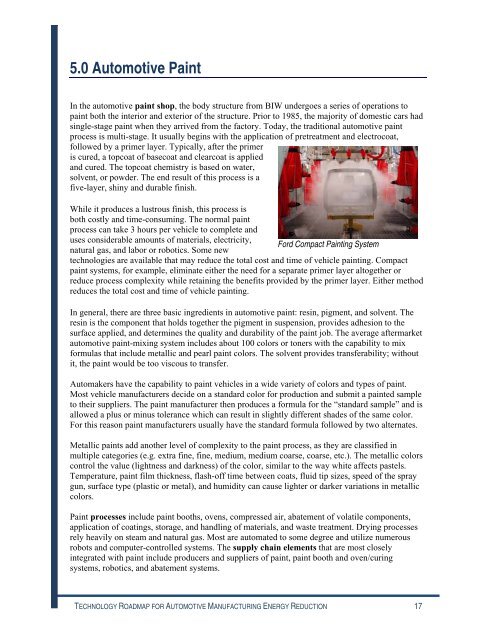Technology Roadmap for Energy Reduction in Automotive
Technology Roadmap for Energy Reduction in Automotive
Technology Roadmap for Energy Reduction in Automotive
You also want an ePaper? Increase the reach of your titles
YUMPU automatically turns print PDFs into web optimized ePapers that Google loves.
5.0 <strong>Automotive</strong> Pa<strong>in</strong>t<br />
In the automotive pa<strong>in</strong>t shop, the body structure from BIW undergoes a series of operations to<br />
pa<strong>in</strong>t both the <strong>in</strong>terior and exterior of the structure. Prior to 1985, the majority of domestic cars had<br />
s<strong>in</strong>gle-stage pa<strong>in</strong>t when they arrived from the factory. Today, the traditional automotive pa<strong>in</strong>t<br />
process is multi-stage. It usually beg<strong>in</strong>s with the application of pretreatment and electrocoat,<br />
followed by a primer layer. Typically, after the primer<br />
is cured, a topcoat of basecoat and clearcoat is applied<br />
and cured. The topcoat chemistry is based on water,<br />
solvent, or powder. The end result of this process is a<br />
five-layer, sh<strong>in</strong>y and durable f<strong>in</strong>ish.<br />
While it produces a lustrous f<strong>in</strong>ish, this process is<br />
both costly and time-consum<strong>in</strong>g. The normal pa<strong>in</strong>t<br />
process can take 3 hours per vehicle to complete and<br />
uses considerable amounts of materials, electricity,<br />
Ford Compact Pa<strong>in</strong>t<strong>in</strong>g System<br />
natural gas, and labor or robotics. Some new<br />
technologies are available that may reduce the total cost and time of vehicle pa<strong>in</strong>t<strong>in</strong>g. Compact<br />
pa<strong>in</strong>t systems, <strong>for</strong> example, elim<strong>in</strong>ate either the need <strong>for</strong> a separate primer layer altogether or<br />
reduce process complexity while reta<strong>in</strong><strong>in</strong>g the benefits provided by the primer layer. Either method<br />
reduces the total cost and time of vehicle pa<strong>in</strong>t<strong>in</strong>g.<br />
In general, there are three basic <strong>in</strong>gredients <strong>in</strong> automotive pa<strong>in</strong>t: res<strong>in</strong>, pigment, and solvent. The<br />
res<strong>in</strong> is the component that holds together the pigment <strong>in</strong> suspension, provides adhesion to the<br />
surface applied, and determ<strong>in</strong>es the quality and durability of the pa<strong>in</strong>t job. The average aftermarket<br />
automotive pa<strong>in</strong>t-mix<strong>in</strong>g system <strong>in</strong>cludes about 100 colors or toners with the capability to mix<br />
<strong>for</strong>mulas that <strong>in</strong>clude metallic and pearl pa<strong>in</strong>t colors. The solvent provides transferability; without<br />
it, the pa<strong>in</strong>t would be too viscous to transfer.<br />
Automakers have the capability to pa<strong>in</strong>t vehicles <strong>in</strong> a wide variety of colors and types of pa<strong>in</strong>t.<br />
Most vehicle manufacturers decide on a standard color <strong>for</strong> production and submit a pa<strong>in</strong>ted sample<br />
to their suppliers. The pa<strong>in</strong>t manufacturer then produces a <strong>for</strong>mula <strong>for</strong> the “standard sample” and is<br />
allowed a plus or m<strong>in</strong>us tolerance which can result <strong>in</strong> slightly different shades of the same color.<br />
For this reason pa<strong>in</strong>t manufacturers usually have the standard <strong>for</strong>mula followed by two alternates.<br />
Metallic pa<strong>in</strong>ts add another level of complexity to the pa<strong>in</strong>t process, as they are classified <strong>in</strong><br />
multiple categories (e.g. extra f<strong>in</strong>e, f<strong>in</strong>e, medium, medium coarse, coarse, etc.). The metallic colors<br />
control the value (lightness and darkness) of the color, similar to the way white affects pastels.<br />
Temperature, pa<strong>in</strong>t film thickness, flash-off time between coats, fluid tip sizes, speed of the spray<br />
gun, surface type (plastic or metal), and humidity can cause lighter or darker variations <strong>in</strong> metallic<br />
colors.<br />
Pa<strong>in</strong>t processes <strong>in</strong>clude pa<strong>in</strong>t booths, ovens, compressed air, abatement of volatile components,<br />
application of coat<strong>in</strong>gs, storage, and handl<strong>in</strong>g of materials, and waste treatment. Dry<strong>in</strong>g processes<br />
rely heavily on steam and natural gas. Most are automated to some degree and utilize numerous<br />
robots and computer-controlled systems. The supply cha<strong>in</strong> elements that are most closely<br />
<strong>in</strong>tegrated with pa<strong>in</strong>t <strong>in</strong>clude producers and suppliers of pa<strong>in</strong>t, pa<strong>in</strong>t booth and oven/cur<strong>in</strong>g<br />
systems, robotics, and abatement systems.<br />
TECHNOLOGY ROADMAP FOR AUTOMOTIVE MANUFACTURING ENERGY REDUCTION 17

















